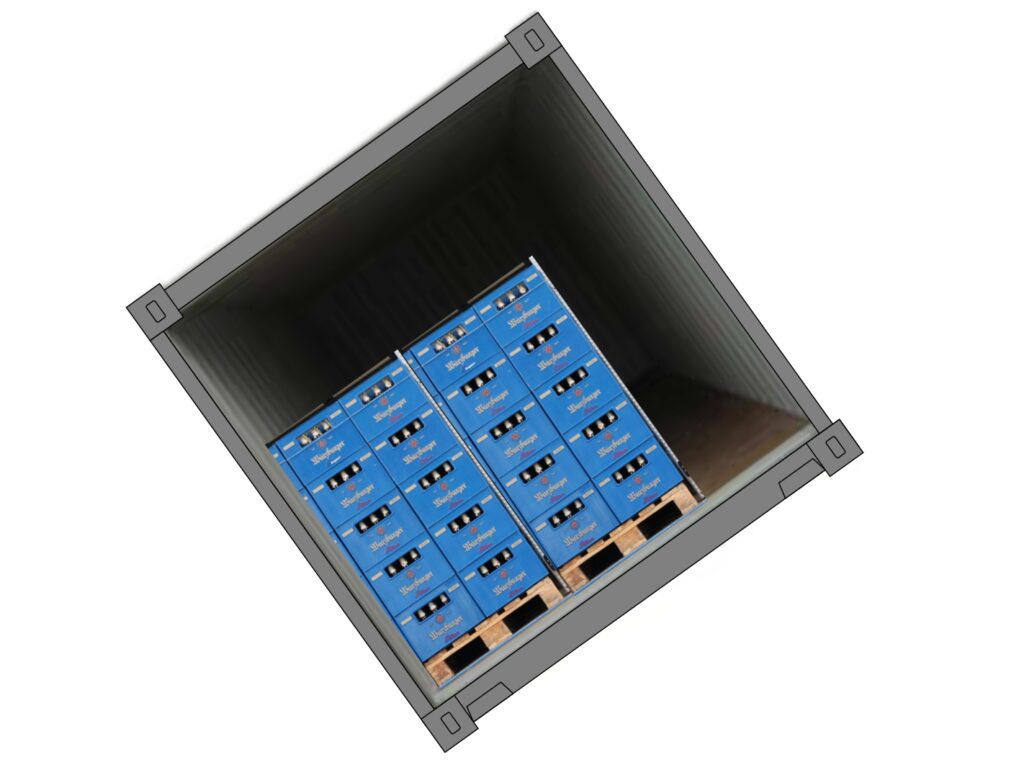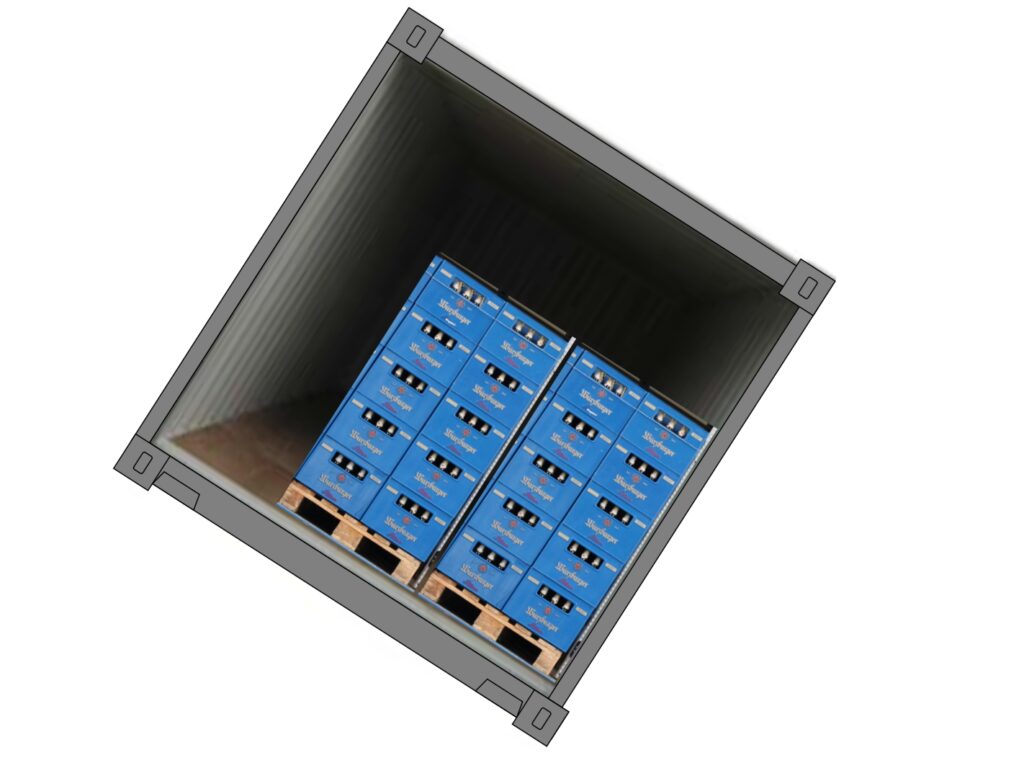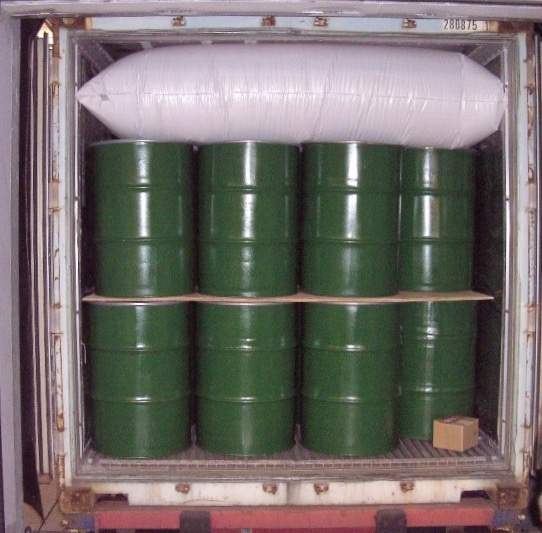
Now 10% off all Ergolash lashing straps save now! Voucher code: ergo10 | Valid until 31.05.2025
A frequently hotly debated topic when it comes to securing loads in containers is the question: should they be secured upwards? As is so often the case, two experts have three opinions, underpinned by well-founded half-knowledge. Unfortunately, this question also has to be based on physics, which is not everyone’s cup of tea.
The CTU code does not make things any easier because it ignores the question and does not provide a concrete answer. The occurring accelerations are precisely defined, which is an advantage for further considerations.
First of all, you have to realize what is the essential difference between a truck and a ship. The truck moves on prefabricated roads that can be more or less good, but it will not, for example, leave the road because the road rotates around its longitudinal axis. The fact that this can be the case under certain circumstances can be seen in this video:
You are currently viewing a placeholder content from YouTube. To access the actual content, click the button below. Please note that doing so will share data with third-party providers.
More InformationHowever, this is not the normal case. The ship, on the other hand, sails on a moving surface and must constantly balance its center of gravity.
The floating ship is a freely movable body with 6 degrees of freedom. It can move around and along three axes simultaneously.

A ship floats because the buoyant force of the displaced water is as great as the ship’s gravitational force.
The figures in the example are fictitious. When the sea moves, the shape of the displaced water and the position of the center of buoyancy change. This pushes against the ship’s center of gravity.
The leverage effect causes it to straighten up again. This happens constantly and this generates accelerations that affect the load.

Readers who are particularly interested can ask Mr. Google under the keyword “Metacenter”.
In the CTU code, the accelerations are listed in this table:

The directions are considered separately, although this is not the case in reality. Accelerations act in all directions simultaneously. The user must now make up his own mind.
A significant difference between the securing calculation for trucks and containers is the assumed vertical acceleration, which affects the frictional force between the load and the load carrier.
Chapter 2.2.2 of the CTU Code contains the following formula for calculating the friction force:

Let’s assume we have a load weight of 1t=1,000kg, a coefficient of friction of µ=0.3 and round up the acceleration to 10m/s2. For the truck we usually assume Cz=1g and for the container the smallest specification with Cz=0.2g
The following calculation would result for the truck:
FR=µ x Cz x m x g
FR= 0.3 x 1.0 x 1t x 10m/s2FR= 3kN = 300daN
The following calculation would result for the ship:
FR=µ x Cz x m x g
FR= 0.3 x 0.2 x 1t x 10m/s2FR= 0.6kN = 60daN
This clearly shows that the effectiveness of securing methods based on high friction is considerably reduced.
Now we come to the core of the problem. When the ship pitches, the vertical acceleration is reduced to 0.2g and at the same time the rolling acceleration is 0.8g.
These graphics are intended to illustrate the problem.
The sum of the small gaps results in a large gap on one side of the container. During the next rolling movement, the entire load will slide into the large gap. It now has more distance to accelerate and absorb energy, which then affects the container wall with force.



In addition, there is the so-called angular acceleration. The acceleration within a container also depends on the distance between its stowage position and the rolling axis.
The further away from it, the longer the distance in the same time, the greater the acceleration.
As a rule, the shipper has no influence on the stowage position.

If the load has been positively stowed and all gaps have been filled/compensated, there is no room for the load to move, even if the friction is reduced.
It is not necessary to secure it upwards in order to maintain the frictional force.
If the gaps cannot be compensated for and the tight fit cannot be achieved, it must be ensured that the friction is not reduced. Securing methods such as direct lashing, tie-down lashing or filling the gaps between the container ceiling and the load must then be used.
A load consisting of loosely stowed barrels cannot be stowed with a tight fit. Securing at the top would make sense here to prevent the load from moving.

When securing against the container ceiling, it should be noted that this is only suitable to a limited extent due to its low stability. The CTU code specifies a maximum load of 300 kg on an area of 60 x 30 cm. This corresponds to a pressure of 0.16kg/cm2.
A dunnage bag may cause the ceiling to bulge and possibly become permanently deformed even at a low internal pressure. This can lead to the ceiling having to be repaired and the last user being left with the bill.
However, depending on the extent of the curvature, it is also possible that the container stowed above it presses the curvature down with its own weight and transfers the force to the goods via the dunnage bag and damages them.
Care must therefore be taken when using dunnage bags against the container ceiling.
Form-fit securing, in which the load is stowed without gaps or the gaps are compensated for, is definitely the better method.
Yours, Sigurd Ehringer
To the next post >>

Sigurd Ehringer
✔ VDI-zertifizierter Ausbilder für Ladungssicherung ✔ Fachbuch-Autor ✔ 8 Jahre Projektmanager ✔ 12 Jahre bei der Bundeswehr (Kompaniechef) ✔ 20 Jahre Vertriebserfahrung ✔ seit 1996 Berater/Ausbilder in der Logistik ✔ 44 Jahre Ausbilder/Trainer in verschiedenen Bereichen —> In einer Reihe von Fachbeiträgen aus der Praxis, zu Themen rund um den Container und LKW, erhalten Sie Profiwissen aus erster Hand. Wie sichert man Ladung korrekt und was sind die Grundlagen der Ladungssicherung? Erarbeitet und vorgestellt werden sie von Sigurd Ehringer, Inhaber von SE-LogCon.
Rothschenk assortment
Our customer center has only one goal: to turn your problems into solutions. Whether standard stowage cushions, bestsellers or load securing personally tailored to your needs -. we accompany you consistently from A as in field service to Z as in certification. That is our promise to you, as a leader in our industry.
We attach great importance to professional cargo securing. That is why we have our own production, which ensures reliable operation through modern manufacturing technologies and strict quality control. Thus, we offer our customers a comprehensive and high-quality range of services in the field of transport logistics.
DIN ISO 9001:2015, EMAS and Ecovadis are not foreign words to you? Then it's time to work with the best.
You don't take any risks with us - we have been awarded the Platinum Medal on the EcoVadis sustainability rating platform.
As a load securement company, we are proud to have several certifications that validate our sustainability efforts and our commitment to environmental protection and social responsibility. For you as a purchaser, this means that we demand and promote the implementation of high environmental and social standards both within the company and along the supply chain.
You are currently viewing a placeholder content from Google Maps. To access the actual content, click the button below. Please note that doing so will share data with third-party providers.
More Information